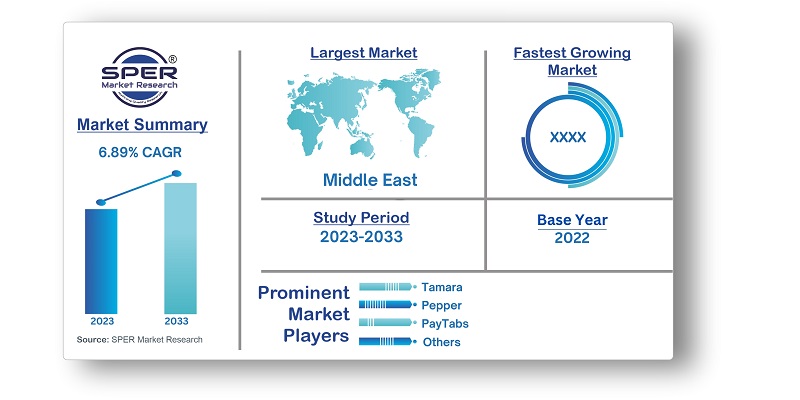
Middle East Fintech Market Growth, Trends, Share, Size, Revenue, Demand and Future Outlook
Middle East Fintech Market Size– By Service proposition- Regional Outlook, Competitive Strategies and Segment Forecast to 2033
| Published: Jan-2024 | Report ID: BFSI2406 | Pages: 1 - 157 | Formats*: |
| Category : BFSI | |||
- October 2022: Forbes Middle East reports that Tamara had three million active users as of October 2022, having completed transactions of USD 267 million in 2021.
- June 2022: The company most recently unveiled PayTabs SwitchOn, an integrated payments and transaction processing platform, PT Touch, the first SoftPOS solution in MENA, and Paymes, a social commerce network to facilitate payments for small companies.


| Report Metric | Details |
| Market size available for years | 2019-2033 |
| Base year considered | 2022 |
| Forecast period | 2023-2033 |
| Segments covered | By Service proposition |
| Regions covered | Bahrain, Egypt, Iran, Israel, Qatar, Saudi Arabia, United Arab Emirates, Rest of MENA |
| Companies Covered | Tamara, Liv. , Pepper, PayTabs, Tabby, Sarwa, Ila Bank, Bayzat, Eureeca, Cwallet and various others. |
- Tourists
- Entrepreneurs and Small Businesses
- Government and Regulatory Bodies
- Financial Institutions and Banks
- Retail Consumers
- Corporate Sector
- Insurance Sector
- Islamic Finance Community
- E-commerce and Retail Industry
- Media and Advertising Agencies
| By Service proposition: |
|
| By Region: |
|
- Middle East Fintech Market Size (FY’2023-FY’2033)
- Overview of Middle East Fintech Market
- Segmentation of Middle East Fintech Market By Service Proposition (Digital Lending & Lending Marketplaces, Money Transfer and Payments, Online Insurance & Insurance Marketplaces, Savings and Investments, Other Service Propositions)
- Statistical Snap of Middle East Fintech Market
- Expansion Analysis of Middle East Fintech Market
- Problems and Obstacles in Middle East Fintech Market
- Competitive Landscape in the Middle East Fintech Market
- Impact of COVID-19 and Demonetization on Middle East Fintech Market
- Details on Current Investment in Middle East Fintech Market
- Competitive Analysis of Middle East Fintech Market
- Prominent Players in the Middle East Fintech Market
- SWOT Analysis of Middle East Fintech Market
1.1. Scope of the report1.2. Market segment analysis
2.1. Research data source2.1.1. Secondary Data2.1.2. Primary Data2.1.3. SPER’s internal database2.1.4. Premium insight from KOL’s2.2. Market size estimation2.2.1. Top-down and Bottom-up approach2.3. Data triangulation
4.1. Driver, Restraint, Opportunity and Challenges analysis4.1.1. Drivers4.1.2. Restraints4.1.3. Opportunities4.1.4. Challenges4.2. COVID-19 Impacts of the Middle East Fintech Market
5.1. SWOT Analysis5.1.1. Strengths5.1.2. Weaknesses5.1.3. Opportunities5.1.4. Threats5.2. PESTEL Analysis5.2.1. Political Landscape5.2.2. Economic Landscape5.2.3. Social Landscape5.2.4. Technological Landscape5.2.5. Environmental Landscape5.2.6. Legal Landscape5.3. PORTER’s Five Forces5.3.1. Bargaining power of suppliers5.3.2. Bargaining power of buyers5.3.3. Threat of Substitute5.3.4. Threat of new entrant5.3.5. Competitive rivalry5.4. Heat Map Analysis
6.1. Middle East Fintech Market Manufacturing Base Distribution, Sales Area, Product Type6.2. Mergers & Acquisitions, Partnerships, Product Launch, and Collaboration in Middle East Fintech Market
7.1. Middle East Fintech Market Value Share and Forecast, By Service proposition, 2023-20337.2. Digital Lending & Lending Marketplaces7.3. Money Transfer and Payments7.4. Online Insurance & Insurance Marketplaces7.5. Savings and Investments7.6. Other Service Propositions
8.1. Middle East Fintech Market Size and Market Share
9.1. Middle East Fintech Market Size and Market Share By Service proposition (2019-2026)9.2. Middle East Fintech Market Size and Market Share By Service proposition (2027-2033)
10.1. Middle East Fintech Market Size and Market Share By Region (2019-2026)10.2. Middle East Fintech Market Size and Market Share By Region (2027-2033)10.3. Bahrain10.4. Egypt10.5. Iran10.6. Israel10.7. Qatar10.8. Saudi Arabia10.9. United Arab Emirates10.10. Rest of MENA
11.1. Bayzat11.1.1. Company details11.1.2. Financial outlook11.1.3. Product summary11.1.4. Recent developments11.2. Cwallet11.2.1. Company details11.2.2. Financial outlook11.2.3. Product summary11.2.4. Recent developments11.3. Eureeca11.3.1. Company details11.3.2. Financial outlook11.3.3. Product summary11.3.4. Recent developments11.4. Liv11.4.1. Company details11.4.2. Financial outlook11.4.3. Product summary11.4.4. Recent developments11.5. PayTabs11.5.1. Company details11.5.2. Financial outlook11.5.3. Product summary11.5.4. Recent developments11.6. Pepper11.6.1. Company details11.6.2. Financial outlook11.6.3. Product summary11.6.4. Recent developments11.7. Sarwa11.7.1. Company details11.7.2. Financial outlook11.7.3. Product summary11.7.4. Recent developments11.8. Tabby11.8.1. Company details11.8.2. Financial outlook11.8.3. Product summary11.8.4. Recent developments15.9 Tamara15.9.1 Company details15.9.2 Financial outlook15.9.3 Product summary15.9.4 Recent developments15.20 Others
SPER Market Research’s methodology uses great emphasis on primary research to ensure that the market intelligence insights are up to date, reliable and accurate. Primary interviews are done with players involved in each phase of a supply chain to analyze the market forecasting. The secondary research method is used to help you fully understand how the future markets and the spending patterns look likes.
The report is based on in-depth qualitative and quantitative analysis of the Product Market. The quantitative analysis involves the application of various projection and sampling techniques. The qualitative analysis involves primary interviews, surveys, and vendor briefings. The data gathered as a result of these processes are validated through experts opinion. Our research methodology entails an ideal mixture of primary and secondary initiatives.



Frequently Asked Questions About This Report
PLACE AN ORDER
Year End Discount
Sample Report
Pre-Purchase Inquiry
NEED CUSTOMIZATION?
Request CustomizationCALL OR EMAIL US
100% Secure Payment






Related Reports
Our Global Clients
Our data-driven insights have influenced the strategy of 200+ reputed companies across the globe.




















